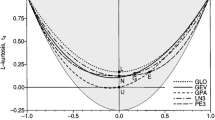Abstract
The extremal index θ, a measure of the degree of local dependence in the extremes of a stationary process, plays an important role in extreme value analyses. We estimate θ semiparametrically, using the relationship between the distribution of block maxima and the marginal distribution of a process to define a semiparametric model. We show that these semiparametric estimators are simpler and substantially more efficient than their parametric counterparts. We seek to improve efficiency further using maxima over sliding blocks. A simulation study shows that the semiparametric estimators are competitive with the leading estimators. An application to sea-surge heights combines inferences about θ with a standard extreme value analysis of block maxima to estimate marginal quantiles.
Similar content being viewed by others
References
Ancona-Navarrete, M.A., Tawn, J.A.: A comparison of methods for estimating the extremal index. Extremes 3(1), 5–38 (2000)
Beirlant, J., Goegebeur, Y., Segers, J., Teugels, J.: Statistics of Extremes: Theory and Applications. Wiley, Chichester (2004)
Canty, A., Ripley, B.D.: boot: Bootstrap R (S-Plus) functions, R package version 1. 3–11 (2014)
Chandler, R.E., Bate, S.B.: Inference for clustered data using the independence loglikelihood. Biometrika 94(1), 167–183 (2007)
Chavez-Demoulin, V., Davison, A.C.: Modelling time series extremes. REVSTAT - Stat. J. 10(1), 109–133 (2012)
Coles, S.G.: Modelling extreme multivariate events. PhD thesis, University of Sheffield, Sheffield, U.K. (1991)
Dabrowska, D.M., Doksum, K.A., Miura, R.: Rank estimates in a class of semiparametric two-sample models. Ann. Inst. Statist. Math. 41(1), 63–79 (1989)
Davis, R., Resnick, S.: Basic properties and prediction of max-ARMA processes. Adv. Appl. Prob. 21, 781–803 (1989)
Davison, A.C., Hinkley, D.V.: Bootstrap Methods and Their Application. Cambridge University Press, New York (1997)
Deheuvels, P.: Point processes and multivariate extreme values. J. Multivariate. Anal. 13(2), 257–272 (1983)
Fawcett, L., Walshaw, D.: Estimating return levels from serially dependent extremes. Environmetrics 23(3), 272–283 (2012)
Ferro, C.A.T., Segers, J.: Inference for clusters of extreme values. J. R. Statist. Soc. B 65(2), 545–556 (2003)
Ferro, C.A.T., Pezzulli, S.: Rao-Blackwellised estimators for parameters of extreme-value models http://empslocal.ex.ac.uk/people/staff/ferro/Publications/raoblackwell.pdf (2005)
Gomes, M.I.: On the estimation of parameters of rare events in environmental time series. In: Barnett, V, Turkman, K (eds.) Statistics for the Environment 2: Water Related Issues, pp. 225–241. Wiley, New York (1993)
Hayfield, T., Racine, J.S.: Nonparametric econometrics: The np package. J. Stat. Softw. 27(5), 1–32 (2008)
Laurini, F., Tawn, J.A.: New estimators for the extremal index and other cluster characteristics. Extremes 6, 189–211 (2003)
Leadbetter, M., Lindgren, G., Rootzén, H.: Extremes and related properties of random sequences and series. Springer Verlag, New York (1983)
Northrop, P.J.: Semiparametric estimation of the extremal index using block maxima. Tech. Rep. 259, University College London (2005)
Patton, A., Politis, D., White, H.: Correction to Automatic block-length selection for the dependent bootstrap by D. Politis and H. White. Econ. Rev. 28(4), 372–375 (2009)
Politis, D., Romano, J.: The stationary bootstrap. J. Am. Statist. Ass. 89(428), 1303–1313 (1994)
Prescott, P., Walden, A.: Maximum likelihood estimation of the parameters of the generalized extreme value distribution. Biometrika 67(3), 723–724 (1980)
Robert, C.Y.: Inference for the limiting cluster size distribution of extreme values. Ann. Statist. 37(1), 271–310 (2009)
Robert, C.Y.: Automatic declustering of rare events. Biometrika 100(3), 587–606 (2013)
Robert, C.Y., Segers, J., Ferro, C.A.T.: A sliding blocks estimator for the extremal index. Electron. J. Stat. 3, 993–1020 (2009)
Smith, R.L.: Maximum likelihood estimation in a class of non-regular cases. Biometrika 72(1), 67–92 (1985)
Smith, R.L.: A theoretical comparison of the annual maximum and threshold approaches to extreme value analysis. Tech. Rep. 53, University of Surrey (1987)
Smith, R.L.: The extremal index for a Markov Chain. J. App. Prob. 29(1), 37–45 (1992)
Smith, R.L., Weissman, I.: Estimating the extremal index. J. R. Statist. Soc. B. 56(3), 515–528 (1994)
Süveges, M.: Likelihood estimation of the extremal index. Extremes 10, 41–55 (2007)
Süveges, M., Davison, A.C.: Model misspecification in peaks over threshold analysis. Ann. Appl. Statist. 4(1), 203–221 (2010)
White, H.: Maximum likelihood estimation of misspecified models. Econometrika 50(1), 1–25 (1982)
Author information
Authors and Affiliations
Corresponding author
Rights and permissions
About this article
Cite this article
Northrop, P.J. An efficient semiparametric maxima estimator of the extremal index. Extremes 18, 585–603 (2015). https://doi.org/10.1007/s10687-015-0221-5
Received:
Revised:
Accepted:
Published:
Issue Date:
DOI: https://doi.org/10.1007/s10687-015-0221-5




